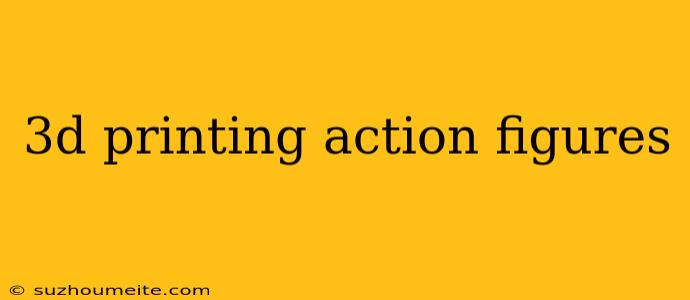3D Printing Action Figures: A New Era in Collectibles
Introduction
Action figures have been a staple of childhood play and adult collectibles for decades. With the advent of 3D printing technology, the possibilities for creating unique and customized action figures have expanded exponentially. In this article, we'll delve into the world of 3D printing action figures and explore the benefits, possibilities, and limitations of this exciting technology.
The Benefits of 3D Printed Action Figures
Customization
One of the most significant advantages of 3D printed action figures is the ability to customize them to an unprecedented degree. With traditional manufacturing methods, producing a unique figure requires a significant investment of time and resources. 3D printing, on the other hand, allows for rapid prototyping and production of one-off figures, making it possible to create bespoke action figures tailored to individual tastes.
Intricate Details
3D printing enables the creation of action figures with intricate details and complex designs that would be impossible to produce with traditional manufacturing methods. The level of precision and accuracy achievable with 3D printing allows for the creation of figures with fine details, textures, and patterns that would be difficult or costly to replicate with traditional manufacturing techniques.
Cost-Effective
3D printing action figures can be a cost-effective option for creators and collectors alike. Without the need for expensive tooling and molding, the cost of production is significantly reduced, making it possible to produce high-quality figures at a lower cost.
The Process of 3D Printing Action Figures
Design
The process begins with designing the action figure using computer-aided design (CAD) software. The designer creates a digital model of the figure, taking into account the intricacies of the character's features, costumes, and accessories.
Slicing
Once the design is complete, the CAD file is sliced into thin layers, which are then sent to the 3D printer.
Printing
The 3D printer uses a variety of materials, such as PLA, ABS, or resin, to print the figure layer by layer. The printing process can take anywhere from a few hours to several days, depending on the complexity of the design and the type of printer used.
Post-Production
After printing, the figure undergoes post-production processing, which may include sanding, painting, and assembling the various parts of the figure.
Challenges and Limitations
Material Constraints
One of the primary limitations of 3D printing action figures is the limited availability of materials suitable for printing. Currently, there are few materials that can match the durability and flexibility of traditional action figures.
Scaling
Another challenge is scaling up production while maintaining quality and consistency. As demand increases, the capacity to produce large quantities of high-quality figures becomes a significant challenge.
Intellectual Property
Lastly, there is the matter of intellectual property rights. With 3D printing, it can be difficult to ensure that the figures being printed are not infringing on existing copyrights or trademarks.
The Future of 3D Printed Action Figures
As 3D printing technology continues to evolve, the possibilities for creating unique and customized action figures will only expand. With advancements in materials science, improved printing technologies, and growing demand, the future of 3D printed action figures looks bright.
Whether you're a collector, a creator, or simply a fan of action figures, the world of 3D printing action figures offers a new frontier of possibilities, promising to revolutionize the way we create, collect, and appreciate these beloved collectibles.
